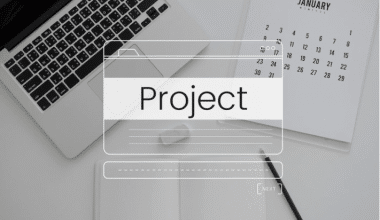There are many various kinds of initiatives, but they all have something in common. They all go through the same cycle, which is referred to as the project lifecycle or project management life cycle. Here, we’ll explain the stages and models of the project lifecycle in detail.
What Is the Project Lifecycle?
The project lifecycle comprises the steps required for project managers to manage a project from start to finish successfully. The project lifecycle is divided into five stages: project initiation, project planning, project execution, monitoring and control, and project closure. Each of these phases is required for the project to be completed successfully.
What are the Stages of a Project Lifecycle?
#1. The beginning phase
The project charter and stakeholder registration are two different activities that comprise the beginning phase of the project lifecycle. This phase is used to define your project’s vision, describe your goals with a business case, and get permission from a sanctioning stakeholder. The following are the essential components of the project charter:
- The business case
- The scope of the project
- Deliverables
- Objectives
- Required resources
- Timeline and milestone plan
- Estimated cost
- Issues and risks
- Dependencies
Taking the effort to properly describe your aims and objectives will make the project easier to work on.
Everyone participating will be allowed to voice their own ideas or concerns, and the budget and prices will be agreed upon and signed off on in advance. This initial phase is critical not only for the project but also for all teams engaged to have a say in what is required for the project.
#2. Preparation phase
The initial step in the planning process should be to outline and clarify the purpose of the project. You can easily identify what the project needs to achieve by answering the following questions.
- What are we going to do?
- How are we going to go about it?
- When are we going to get started?
- When will we know we’re done?
As part of the planning process, you will need to collaborate with the team to set up the entire infrastructure and distribute specific duties. This strategy should include the following elements:
- Project management strategy
- The scope of the project
- Structure of work breakdown
- Plan your resources
- Budget forecasting
Putting the plan in place with the participation of the entire team can be difficult. However, allowing every department to participate in the strategy will result in fewer problems down the road.
#3. The execution phase
The following critical components should be included in the execution phase:
- Team building
- Participation of stakeholders
- Quality control
- Communications
- Client administration
This is the phase in which the majority of the budget is allocated and the majority of the project deliverables are generated. You put your project strategy into action, whether it takes weeks, months, or years.
The purpose of this phase, according to Villanova University, is to “manage teams effectively while orchestrating timeline expectations and meeting benchmark goals.”
Communication is critical during this time since the customer or stakeholders will demand updates and progress reports.
Having a dependable project management system in place will save you and your team a lot of hassles. It will be easy to mark off tasks, understand where deadlines and deliverables are at, and provide you and the team with insight into what still has to be done.
#4. The monitoring and control phase
During the monitoring and controlling phase, you must ensure that you can maintain track of both the general development of the project and individual components.
You must always remain watchful and keep up with tracking and reporting with the team so that you are aware of any possible problems before they escalate.
It is also beneficial to have another member of the project team (or one from each department) work as another quality controller or reporter; they may assist you in keeping track of everything in their team and have regular meetings to update on all aspects, keeping everyone on track.
#5. Completion Phase
The closure phase is the final stage of the project life cycle. It is more than simply marking the project as completed and closing it down. It is critical to formally close the project and obtain approval or sign-off from the client, stakeholders, and/or project sponsor.
This procedure may contain the following steps:
- Completing the project
- Organizing a post-mortem gathering
- Keeping project records
- Celebrating or recognizing the accomplishment
- Disbanding or releasing the team officially
The significance of this final stage of the project life cycle cannot be emphasized, particularly as more firms adopt the Hollywood model of work, in which temporary teams form around a certain project, then dissolve and regroup for another. This is especially critical for project management teams that include freelancers or consultants.
Project LifeCycle Models
A project will go through one of four lifecycle models by the time it is done, depending on the nature of the project and the organization. The predictive, iterative, incremental, and agile life cycles are all viable project management methodologies that include multiple phases and outcomes depending on the objectives and scope complexity.
#1. The predictive lifecycle
There are five stages in the predictive life cycle: initiate, plan, execute, control, and closure. The project team moves through these phases in a straight line, completing each step once and only going on to the next phase once the previous one is finished. The client receives a single product or service. The majority of the planning for this life cycle is done in advance.
#2. The iterative life cycle
The iterative life cycle is similarly divided into five parts, with the end result being a single product or service. Instead of advancing through each step in a linear progression, the phases in an iterative life cycle are repeated as many times as necessary, making it best suited to projects with an unknown scope and where the primary goal is to get the best possible solution for the customer. The majority of the planning will take place throughout the process as consumer input influences the following phase.
#3. The incremental lifecycle
The project team will progress through each phase of the incremental life cycle only once and in order, numerous times in one life cycle, creating a final product at the conclusion of each set. Each increment’s feedback will influence the next. This life cycle is also well-suited to projects with erratic scopes, particularly those where timeliness of delivery is critical.
#4. The Agile lifecycle
The Agile life cycle combines iterative and incremental life cycles. The commencement phase will occur once at the start of the project, followed by iterations of the planning, execution, and control phases as needed. The finished product is provided to the consumer after each iteration. This product’s input will then be used to guide the following increment. This will be repeated as many times as necessary until the client is entirely pleased, at which point the closing step will begin.
The Agile life cycle works best for projects with an uncertain scope and a high premium on regular feedback and delivery.
It is critical to remember that not all projects will neatly fit into the typical life cycle models. A combination of life cycles or a hybrid is often a useful technique, depending on the nature of the project or organization.
Project Lifecycle Management
The management of a project or portfolio of projects as they go through the normal stages of the project lifecycle is referred to as project lifecycle management. This discipline entails overseeing everything needed for these stages. From proposals and pricing to execution and project governance to closure and handover, the concept of project lifecycle management informs Project Business decision-making.
Finally, there is a mechanism in place to handle the full project lifetime. Project Business Automation is a process-first business solution for a project-driven activity that controls both financial and operational parts of your business operations throughout the project lifecycle.
Understanding Project Lifecycle Management
Effective Project Lifecycle Management, which is often performed by the PMO, brings together multiple departments, disciplines, personnel, and information engaged in the project to simplify their activities with the ultimate goal of delivering a project on time and under budget.
Beyond project management, Project Lifecycle Management is an organizational activity. It is the overall discipline of project lifecycle management, not the project itself. It is concerned with how your organization manages project lifecycles.
Project Lifecycle Vs Project Lifecycle Management
The “project management life cycle” is not the same as the “project life cycle.” The project life cycle refers to the various stages of development that a project can go through. As an example:
Evaluating – Designing – Building – Testing – Launching
Design – Coding – Testing – Training – Distribution
The phases of a project are dictated by the nature of the project. The project life cycle is customized to meet the demands of each project. In contrast, the project management life cycle remains consistent throughout all initiatives.
Relationship Of Project Management Life Cycle To Phases Of The Project Life Cycle
This is where things become quite perplexing. Each step can be viewed as a separate project with its own complete project management life cycle. The following diagram depicts the stages of the project management life cycle for the design phase of the project life cycle. The design phase is effectively a separate project that results in a deliverable. This deliverable is used as an input in the coding phase, which can then be used throughout the project management life cycle.
Software for Project Lifecycle Management
Project Lifecycle Management Software assists organizations in dealing with the complexities and specific problems of project delivery as a business. This solution combines the numerous procedures and data required to manage the project lifecycle. Project management and operations, project financials and accounting, project insight and analytics, and project portfolio management are examples of these.
PBA (Project Business Automation) is a solution that includes Project Lifecycle Management. PBA manages all parts of a project’s lifecycle and integrates them into a comprehensive business system that integrates them into the overall management procedures of the organization. As a result, everyone in the organization works from a single source of truth, enhancing efficiency, visibility, and effectiveness.
What Are the Stages of a Project Life Cycle?
A project’s life cycle includes the phases of intake, commencement, planning, product selection, execution, monitoring and control, and closing.
What Are the Five Phases Of Agile?
The envisage phase, hypothesize phase, explore phase, adapt phase, and close phase are the five phases of the Agile Project Management system.
What Are the 4 Cycles Of Project Management?
The four project management cycles are planning, build-up, implementation, and closeout.
What Are The Six Aspects of A Project?
Timeliness, Costs, Quality, Scope, Benefits, and Risk are the six aspects of a project.
Related Articles
- LIFECYCLE MARKETING: Meaning, Strategy, Model, Canager & Customer Marketing
- ASSET MANAGEMENT SYSTEM: Benefits & Top 5 Software Solutions
- Implied Volatility (IV): Formula and Calculator (+detailed steps for calculating IV)
- CONTRACT MANAGEMENT: What Is It, Process & Lifecycle






